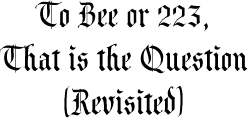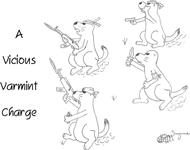- Messages
- 938
- Reactions
- 269
Follow along with the video below to see how to install our site as a web app on your home screen.
Note: This feature may not be available in some browsers.

 [SIZE=-1]The Author's rendition of Barry[/SIZE]
[SIZE=-1]The Author's rendition of Barry[/SIZE]
 produces recoil similar to the .17 Reminegton, has a report like a Hornet, and hitting power that surprised even Barry. Barry says "I DO like that load!"
produces recoil similar to the .17 Reminegton, has a report like a Hornet, and hitting power that surprised even Barry. Barry says "I DO like that load!"
 Back in the October 1995 issue of the "Varmint Hunter Magazine", Barry and I did an article on reduced loads for the 223. In that article, we discussed both the standard load and the reduced load, or "Gopher Load" as it has become known. By using the gopher Load in a 223, one can easily duplicate the performance of the 218 Bee, an all time favorite. Your trusty 223 varmint rig can now become two entirely different rifles, simply by changing ammo.
Back in the October 1995 issue of the "Varmint Hunter Magazine", Barry and I did an article on reduced loads for the 223. In that article, we discussed both the standard load and the reduced load, or "Gopher Load" as it has become known. By using the gopher Load in a 223, one can easily duplicate the performance of the 218 Bee, an all time favorite. Your trusty 223 varmint rig can now become two entirely different rifles, simply by changing ammo. believe me, the 223 Gopher Load runs circles around the 22 Rimfire Magnum both in accuracy and range. With the Gopher Load, 1/2" groups are the norm at the effective range of 200 yards. Finally, because of the greatly reduced powder quantities, expect barrel life to increase by several thousand rounds. (I guess this doesn't excite Barry, as he belongs to the Gun-a-Month Club.)
believe me, the 223 Gopher Load runs circles around the 22 Rimfire Magnum both in accuracy and range. With the Gopher Load, 1/2" groups are the norm at the effective range of 200 yards. Finally, because of the greatly reduced powder quantities, expect barrel life to increase by several thousand rounds. (I guess this doesn't excite Barry, as he belongs to the Gun-a-Month Club.)